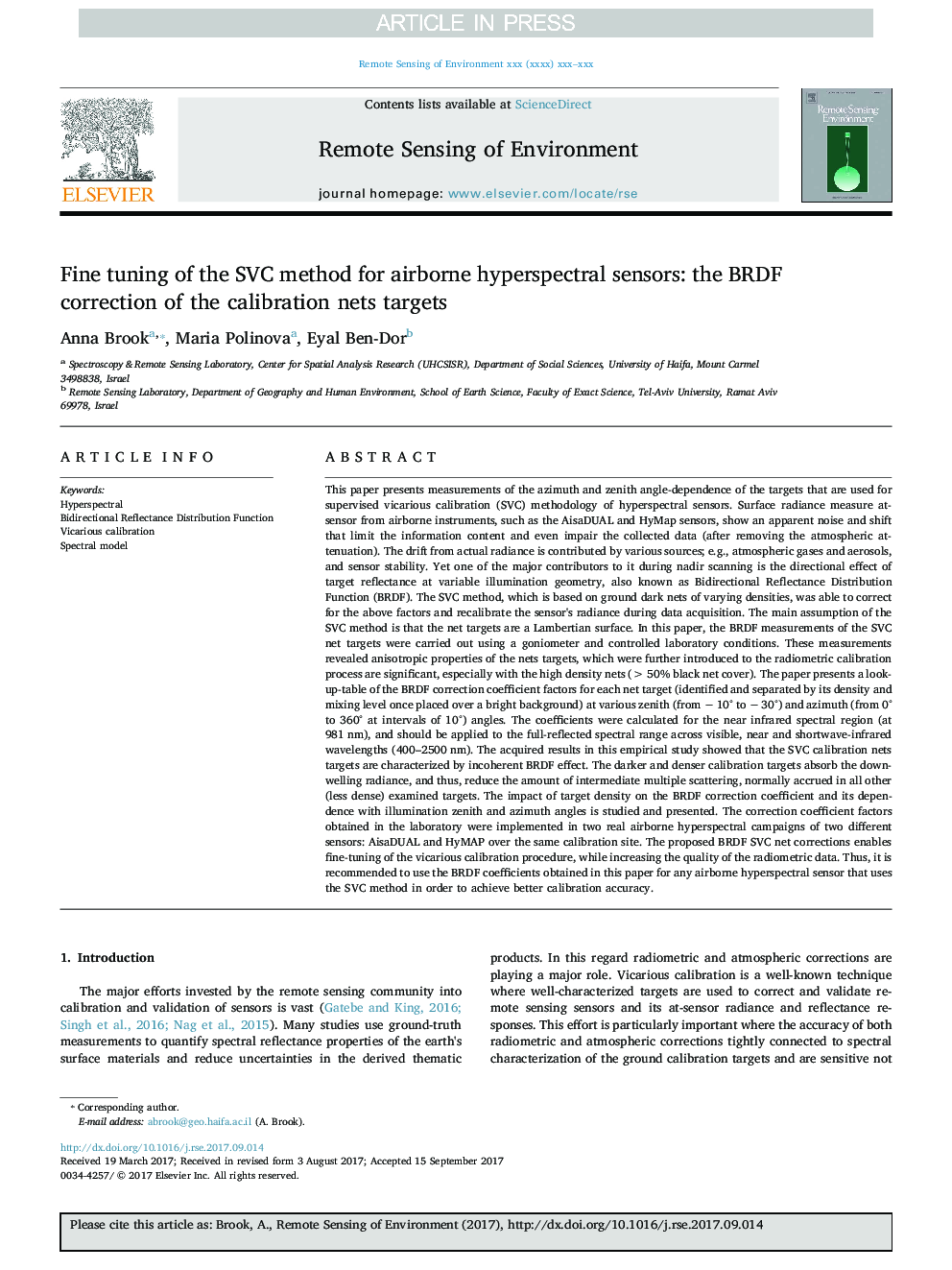| کد مقاله | کد نشریه | سال انتشار | مقاله انگلیسی | نسخه تمام متن |
|---|---|---|---|---|
| 8866907 | 1621196 | 2018 | 11 صفحه PDF | دانلود رایگان |
عنوان انگلیسی مقاله ISI
Fine tuning of the SVC method for airborne hyperspectral sensors: the BRDF correction of the calibration nets targets
دانلود مقاله + سفارش ترجمه
دانلود مقاله ISI انگلیسی
رایگان برای ایرانیان
کلمات کلیدی
موضوعات مرتبط
مهندسی و علوم پایه
علوم زمین و سیارات
کامپیوتر در علوم زمین
پیش نمایش صفحه اول مقاله

چکیده انگلیسی
This paper presents measurements of the azimuth and zenith angle-dependence of the targets that are used for supervised vicarious calibration (SVC) methodology of hyperspectral sensors. Surface radiance measure at-sensor from airborne instruments, such as the AisaDUAL and HyMap sensors, show an apparent noise and shift that limit the information content and even impair the collected data (after removing the atmospheric attenuation). The drift from actual radiance is contributed by various sources; e.g., atmospheric gases and aerosols, and sensor stability. Yet one of the major contributors to it during nadir scanning is the directional effect of target reflectance at variable illumination geometry, also known as Bidirectional Reflectance Distribution Function (BRDF). The SVC method, which is based on ground dark nets of varying densities, was able to correct for the above factors and recalibrate the sensor's radiance during data acquisition. The main assumption of the SVC method is that the net targets are a Lambertian surface. In this paper, the BRDF measurements of the SVC net targets were carried out using a goniometer and controlled laboratory conditions. These measurements revealed anisotropic properties of the nets targets, which were further introduced to the radiometric calibration process are significant, especially with the high density nets (> 50% black net cover). The paper presents a look-up-table of the BRDF correction coefficient factors for each net target (identified and separated by its density and mixing level once placed over a bright background) at various zenith (from â 10° to â 30°) and azimuth (from 0° to 360° at intervals of 10°) angles. The coefficients were calculated for the near infrared spectral region (at 981 nm), and should be applied to the full-reflected spectral range across visible, near and shortwave-infrared wavelengths (400-2500 nm). The acquired results in this empirical study showed that the SVC calibration nets targets are characterized by incoherent BRDF effect. The darker and denser calibration targets absorb the down-welling radiance, and thus, reduce the amount of intermediate multiple scattering, normally accrued in all other (less dense) examined targets. The impact of target density on the BRDF correction coefficient and its dependence with illumination zenith and azimuth angles is studied and presented. The correction coefficient factors obtained in the laboratory were implemented in two real airborne hyperspectral campaigns of two different sensors: AisaDUAL and HyMAP over the same calibration site. The proposed BRDF SVC net corrections enables fine-tuning of the vicarious calibration procedure, while increasing the quality of the radiometric data. Thus, it is recommended to use the BRDF coefficients obtained in this paper for any airborne hyperspectral sensor that uses the SVC method in order to achieve better calibration accuracy.
ناشر
Database: Elsevier - ScienceDirect (ساینس دایرکت)
Journal: Remote Sensing of Environment - Volume 204, January 2018, Pages 861-871
Journal: Remote Sensing of Environment - Volume 204, January 2018, Pages 861-871
نویسندگان
Anna Brook, Maria Polinova, Eyal Ben-Dor,